A Conversation with printmaker Sophie Loubere
During the summer of 2025 I participated in a printmaking residency at In Cahoots in Petaluma, California. In residence with me were three other printmakers and a poet. We got to know each other a little over the two weeks that we shared space—in the studio, on outings, at meals. Sophie Loubere stood out as an artist deeply invested in the conceptual nature of historical imagery while exploring materials and processes. She moved from working with wood type on a Vandercook to chemical etching to handworking intaglio plates and back again. Always smiling, ready to share knowledge and information, while deeply focused on her tasks at hand. This conversation took place in the etching studio towards the end of our residency.

Nanette: How did you come to art?
Sophie: I started in elementary school, and it was just something that I was good at. I started using pastels, like chalk pastels, and I was making pastel paintings with those, and I was getting positive responses, and then I just kept on going, and eventually it was just one of those things where it just felt like it was what I needed to do, which I’m sure a lot of artists can relate to.
Nanette: Did you go to art school right after high school?
Sophie: I went to the University of Illinois at Urbana Champaign, and I was an art major. But while I was there, I was just feeling like the curriculum wasn’t really serving my needs, so I wound up transferring to Rhode Island School Design in their illustration program. I’ve always been interested in words and books and writing as well. So for a while, I thought that I would potentially become an illustrator. But then my interests just wound up being a little too noncommercial, a little too artsy fartsy, more interested in material, more interested in concept, and making artist books as opposed to illustrations for editorial and things like that.
When I went into the illustration program, I didn’t fully understand that the conventional commercial way of making money doing illustration would be to make illustrations for editorial magazines or for working in animation and designing characters for game studios and things like that, and that just was not really where my interests lay. Then one winter session, I wound up taking a printmaking course, Painterly Prints, and I learned aquatint and monoprinting.

After that I was really into etching. I spent my senior year mostly doing etching projects working on this extended sort of book project. After I graduated, I set up my own studio in Seattle. I was working as a graphic designer and publications manager at a nonprofit art school. I also had a little studio and I wound up getting some grant money so I was able to get a little press and then I basically just explored varieties of ways of doing printmaking. I was feeling a little bit frustrated because I didn’t have a conventional printmaking background because I hadn’t majored in it when I was an undergrad. I was trying to learn from books, YouTube videos. I taught myself how to mezzotint, and eventually I just felt like I needed some more specific background. I applied for grad school. I got into a grad school that had a pretty in-depth printmaking program and that’s where I honed both my practice as well as my printmaking skills.
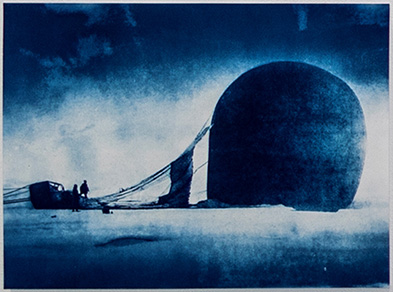
Nanette: So you’re primarily a printmaker?
Sophie: At this point, yes. I’m open to making in pretty much any particular way. I have worked with fabrics before. I’ve done installation. I’ve done audio and video work to go along with the prints. But I think that primarily when I’m thinking conceptually, the majority of the time it winds up being a print in some way or other, and print doesn’t necessarily mean something that is like a letterpress print. I also have done things working with cyanotypes and alternative photography. I view those things as prints as well.
In my view, there’s a lot of different meshing that goes on between all these different artistic media. I would say that printmaking falls into a lot of different categories.
Nanette: Are you still making books?
Sophie: I am. The issue with the books is that they take a lot of time and materials. The way that I’m working right now, since I left grad school, I haven’t really had access to papermaking, which is another aspect that I was exploring in school. So in lieu of that, I wound up deciding to experiment and figure out how to dye paper. I’ve gotten cotton papers and I’ve been dyeing them with natural dyes and there’s a lot of experimentation, a lot of failure that goes along with that, and creating a long form book, I think, with that, I have created a book, but it feels like more of a mock up at this point. I think in order to make a full book, I’m going to need access to papermaking resources, access to letterpress studios.
I have a couple of different books I want to make, but I’m not really feeling like I have access to the facilities I need in order to make them. They kind of feel like projects that I’m always planning in my head. I have materials that I’ve collected, I’ve dyed book cloth that I’m going to make using indigo, and it’s just kind of sitting there waiting for me to make a portfolio box with it at some point here. So, yes, I am still making books, and I would say that even if the prints I’m making are not going into a traditional book form, I am always thinking of them in relationship to each other. When I put them together, I’m thinking of them as a narrative. They all explore some type of creation or visualization.
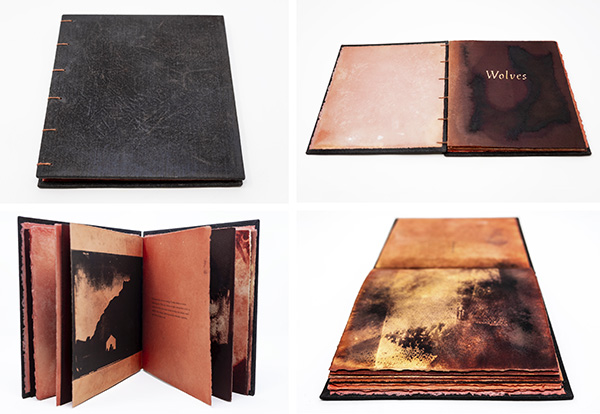
I work a lot with like archival imagery. I try to think of different ways of telling the same story or thinking about different ways of viewing things through a certain perspective. For example, I might take an archival image that I found on the Internet that was taken by a photographer in the 1800s, and then do a reprint of that on expired photo paper, and then I will solarize it and do all sorts of things, just the expired paper on its own will slightly abstract this image and shift how viewers see whatever that image is showing. Then I might take that image, scan it and then make a stone lithograph from it. Then I also might take that image that I’ve scanned and make a relief plate from that and have a piece of paper that I’ve dyed using madder and iron, and it’s really deep dark purple, and then take that piece of paper and put bleach on the lino, and then you get a completely different image based on what is pulled out from the bleach versus what is on the stone, versus what is in the photograph, versus what is in the original slide.
Nanette: It sounds like you’re really interested in materials and processes.
Sophie: Yes.
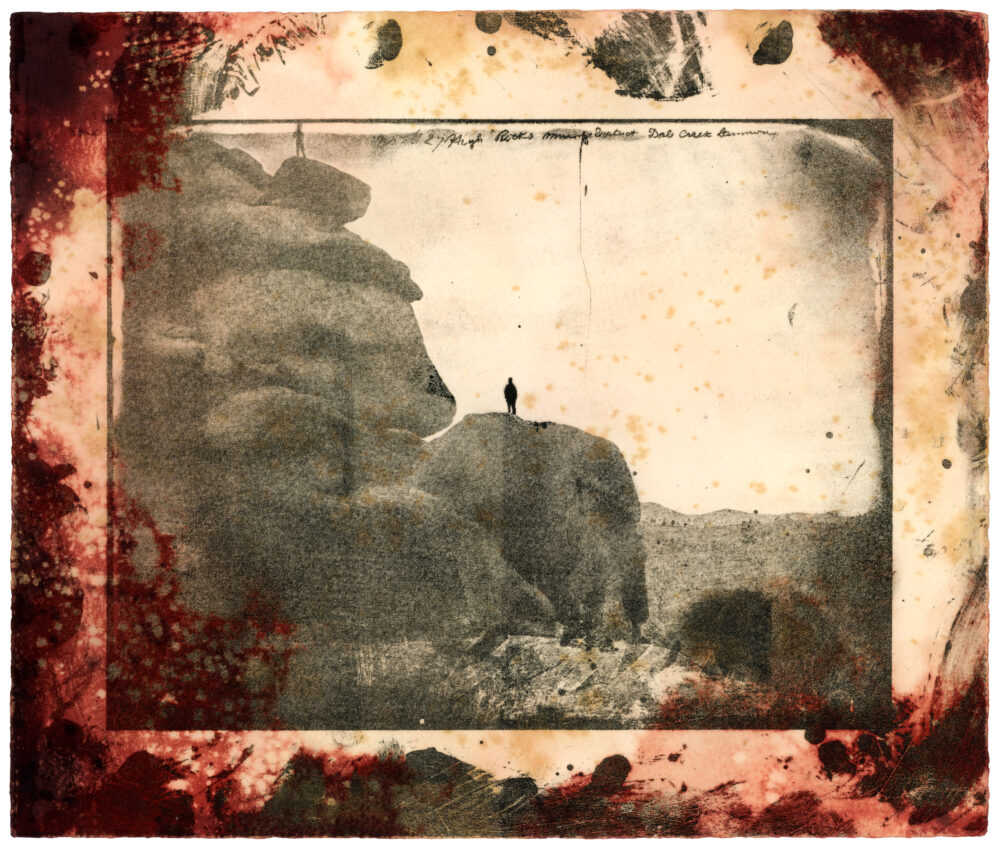
Nanette: I’ve noticed, here, you’re working on three different projects during your residency?
Sophie: Mostly it’s two. I just wanted to finish one set of prints that I’m putting into a show. Partly what is informed what I’m doing here also is that I have this show coming up and I wasn’t quite able to finish before traveling here.
I did a pop up studio at Bainbridge Island Museum of Art where I was working with wood type and I was really enjoying the immediacy of that. The work I do is planned and goes through a series of stages. I really put everything through the ringer. It has different times where it exists in certain ways. I think that development helps to add depth to the imagery and grows the imagery in particular ways, and also mimics time and the depth of the narratives I’m working with.
But it’s fun to have these more immediate ways of working, using wood type. Somebody’s already created these. They have their own histories as well. Who knows how many different things these letters have said over the years. It’s rewarding to be able to take those pieces and put them together in particular ways and, after a day, have a brand new print. That is another really interesting way of working and it adds a certain spontaneity that I might not get in my other work.

One of the things about my practice is that one of the reasons I do a bunch of different things is because I just get interested in a bunch of different stuff and I like to explore a bunch of different stuff. If I’m doing the same thing over and over and over again, I start to get a little stir crazy. Being able to add this sort of thing to my practice, first of all, it potentially makes imagery that I can sell for a little bit more cheaply. I know that that’s not necessarily something everybody wants to hear from an artist, but the truth of the matter is that a lot of the stuff that I’m making because it’s such a time intensive process, it’s hard to price it at super cheap prices like $50 or whatever, but a letter press print, I could easily see selling it for 30, 40, 50 bucks or something like that.
I was just interested in expanding and growing my practice. I have experience as a graphic designer. I worked for a while in house and I also have done freelance projects and everything. So I really enjoy working with type. I also enjoy writing. It’s just another way of expanding on all of that, I guess.
Nanette: The Ultraviolet Evening print, is this a reference to Andy Warhol?
Sophie: Did he do something with that?
Nanette: I think Ultraviolet is associated with Warhol, or Lou Reed. That’s what my memory says. She was an actress or model.
Sophie: Oh, might be. Yeah, it sounds like something to do with Lou Reed.
Nanette: They were connected back in the beginning times.
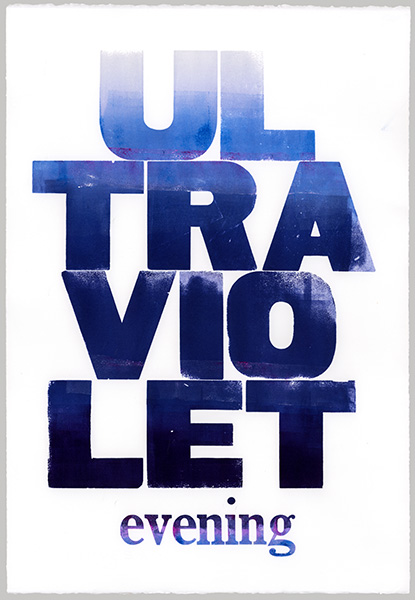
15″ x 22″, varied edition of 12, 2025
Sophie: That is true. The beginning times. Actually, this is the third in a series, the three prints I’ve been making while I’ve been here, that all are 11 by 22. I was using these two type faces together. They can either exist on their own or they come together and create a poem. So this is the last one, and the poem moves through parts of the day. The first one is vibrating and green. The second one is sunset golds, golden hour. This last one I was thinking of that time of day when you go out and the sun has just set and the sky is that really vibrant, sort of periwinkle color, and also, ultraviolet. Part of me always thinks of ultra violent. There’s just something interesting to me about the way words can change. It’s also true that when I was in high school, I really, really liked the color purple, and my mother always went and did Friday Night protests against the Iraq War on the street corner. She had a poster board that she wrote that said, “Stop the cycle of violence.” And I thought it said, “Stop the cycle of violet.” I thought she was making fun of me because I had painted my entire room purple.
Nanette: That’s so funny.
Sophie: I guess I’m interested in words and imagery with words and illustrating things with words. Letterpress and wood type allow me to do that in a really spontaneous way that doesn’t come into the rest of my practice. This residency has allowed me the opportunity to play with that. Once I get home I might be able to explore more of this.
Nanette: I’ve noticed your etchings look very nature inspired. Do you want to tell me about that?
Sophie: Sure. I have a plate that is 9 by 12 that I made and I wanted to make a smaller, sister plate to that. One of the things I’m interested in is having something to respond to, to discuss the idea of nature in relationship to a lot of the other imagery I’m working with, because a lot of the imagery I’m working with right now and have been for the last few years, has been this specific set of glass plates taken by Andrew J. Russell in the 1870s. A lot of the plates he took were out in the American West before the railroads really started to bring a lot of the settler colonialism out. The imagery is a lot of big open spaces, and the humans are all these little tiny specks. You have these big open fields, big hills, giant rocks, and interesting landscape, and then these train tracks that are being built. He was part of the original geological team that went out and figured out whether or not Yellowstone was a place of interest. Because of that documentation, Yellowstone become the first national park.
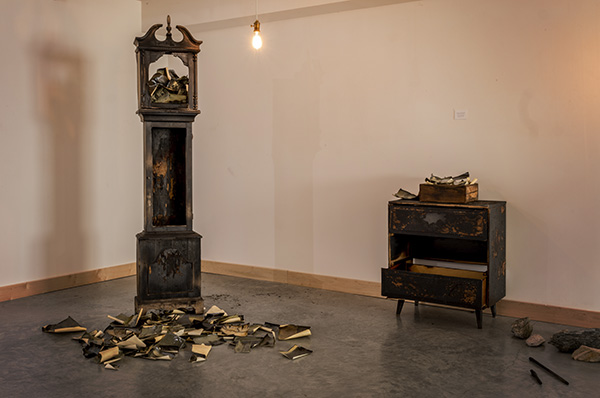
I’ve been using these glass plates, and there’s very specific imagery in these glass plates, too, and they’re also from one person’s perspective. However, there was also a painter, Thomas Moran, that went with them, and he made sketches. These sketches became monumental paintings when he returned home. These paintings of Yellowstone that he created were amalgamations of his sketches and an artist idealized creation of real spaces. While they might be called “Mammoth Hot Springs”, the pieces painted are a collage of his sketches from a variety of areas. So they’re this really romanticized view of what was happening out there. I’m a little bit obsessed with grass, so these plates are these romantic ideals of close ups of grass, especially in relationship to these glass plates, which are really much more pulled out, panned out imagery, and they’re also created by the human hand.
Nanette: You’re getting to work with the original glass plates?
Sophie: No. They’ve all been scanned at super high resolution by Oakland Museum of California and they’re all online. I was able to download and look through them. There’s over 600 of them. It’s pretty incredible. They’re super high res. But I have not actually seen the original glass plates.
Nanette: It seems like the content that you’re interested in is really about the relationships between history and the documentation of natural spaces or documentation of the land.
Sophie: That’s definitely part of it. There’s another part of the work where I go into archives. I do research and find stories. Then I take those stories and rewrite them. Obviously it’s all through my particular lens, but if I’m finding stories about specific people, I try to find the first person documentation of whatever that history is. Then I take those stories and I rewrite them into these 300 to 700 words little vignettes. These come together as literary essays.
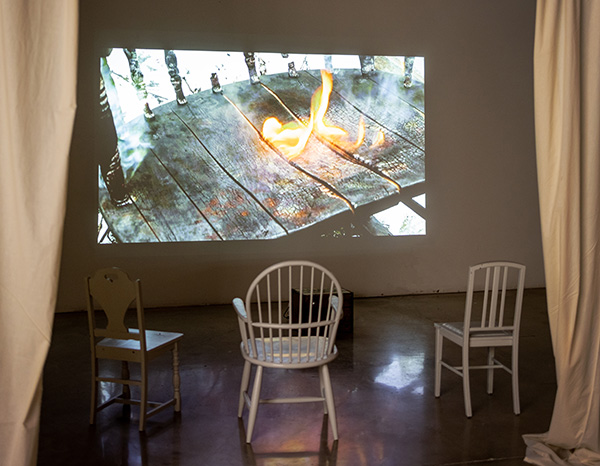
For my thesis show, which was a big installation in a 34 by 50 foot warehouse. I had ten of these vignettes that I printed using photo litho plates on 18 by 24 inch handmade paper. The stories would range from the great fire of 1910, to an Apache horse heist in San Antonio in the 1700s, to the atomic bomb tests at Frenchman Flat in the mid 20th century, to the formation of the Permian basin in Texas 600 million years ago. It goes all over the place. That show was called Trespasses. It was really about human interaction with natural spaces.
I wound up collecting some rocks from the Great Salt Lake region that were 60 million years old. They were part of the installation.
Nanette: Was it legal to take them?
Sophie: It wasn’t at a national park. I didn’t see any signs around saying I couldn’t do it. [laughs] It’s really about human interaction with natural spaces and nature and just thinking about how we have existed in all of these different time periods and the similarities between those things.

Nanette: We? Do you mean humans?
Sophie: Humans and how we have existed and what ways in which we’ve existed. Thinking about how when we were settling/invading the West, the government just had people going out, and they were on their own. It was how America became America to a degree. The values behind it was part of what was going on with the research for that show, thinking about how and why we are the way we are. There’s still a lot of interesting things I want to look at in that research.
I’ve been doing a lot of research into Mormonism thinking about cults and the way we worship celebrity and things like that.
Nanette: Did you read Under the Banner of Heaven?
Sophie: I watched the show, that was pretty dark.
Nanette: That’s just one little story, but it does tell the history of the Mormon religion.
Sophie: I’ve read some, and I actually listened to a lot of audio books and one of them was about the forming of Mormonism in Illinois and how they had like were basically run off of all of these different places. It’s really interesting and also just such a deeply American religion. They believe that they will become gods at some point.
Nanette: And that the relationship with God is a very personal, one-on-one thing
You have a show coming up and what’s the title of that?
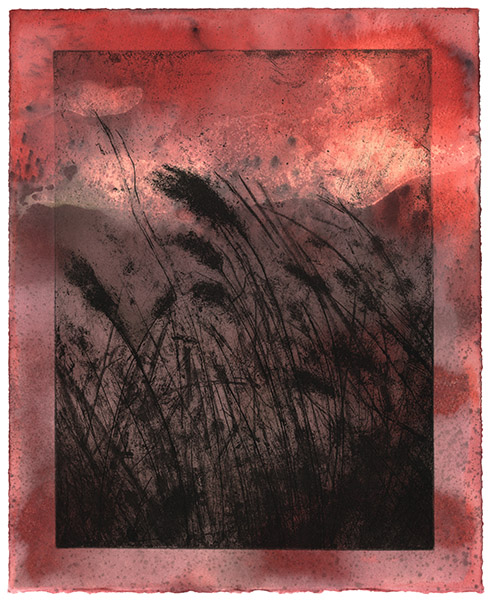
Sophie: It’s not a solo show. It’s part of a group exhibition of artists in Port Townsend. It’s called The Showcase.
The body work I’m working on right now with dyed paper, I am calling On the horizon, in the air, because I’m looking at a lot of far away horizons, pulling clouds and highlights out using bleach. I have this interplay between the dyed paper, which is dyed using natural dyes like madder and wattle, and then the bleach, which is really caustic. If I let it sit in the paper enough, it will eat the paper.
Nanette: You’re using wattle and madder, and madder is red?
Sophie: Madder is red. Wattle is a tannin, which helps they dye adhere. There are many different types of tannins, but this one adds a beige pink tone that shifts the vibrancy of madder’s red.
First I take the paper and put it in aluminum acetate for a couple of days in water and then that goes into the madder and wattle and that goes into, I have to put immersion heaters into the tray with the water and it gets up to like 200, 250 degrees and it’s in there for an hour, hour and a half and then right after that is when I have to bleach it. If I let it sit, the bleach won’t be able to pull out the pigment anymore.
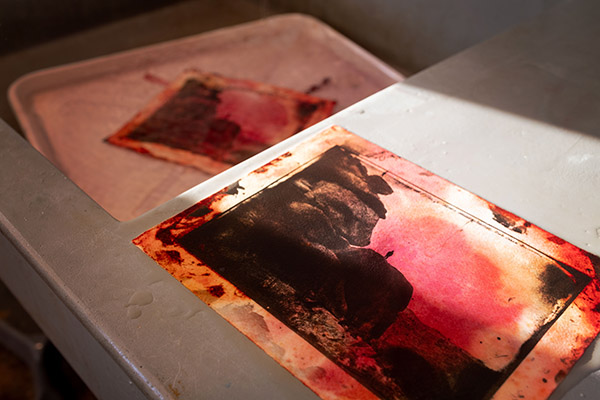
Nanette: So you’re preparing for an exhibition now. What do you think is going to happen after that? What do you have in mind?
Sophie: I’ve done all these prints, I’d like to try to get a shop set up on my website and see what happens with that. I currently am not teaching at a university this year, so my time is a bit more open, so I’m probably going to try to explore a little bit more of the business aspect of being an artist and see how that potentially works as well as trying to do some teaching locally. Weekend workshops with kids or whatever. Then if it feels like this is going to be something that is useful, I might try and do some more wood type things at places close to home. Mostly I’m going to try to keep exploring the body of work I’m doing now because it feels like I’m getting to it. I’ve been doing this for a year, a year and a half working with these materials and it feels like I’m starting to get to a place where I’m really understanding it.
I also recently built some screens so I can add screenprinting as another part of what I’m doing. I’m also probably going to start to do some tone cyanotypes and play around with that a little bit too, because I have a UV box that I’ve built. Just keep exploring the studio processes. I guess I’m kind of all over the place, but, you know, I’m living in a beautiful area. I have a supportive family and even though the world seems absolutely wild, I feel pretty lucky in a lot of ways.
Sophie Loubere is an interdisciplinary artist and educator located in the Puget Sound region. Her work is rooted in research and focuses on printmaking, handmade paper, and alternative photography. Loubere earned an MFA in Printmaking at the University of Wisconsin-Madison and a BFA in Illustration at the Rhode Island School of Design.
sophieloubere.com
In Cahoots Residency
This interview was conducted by Nanette Wylde in August 2025 at In Cahoots Residency.
